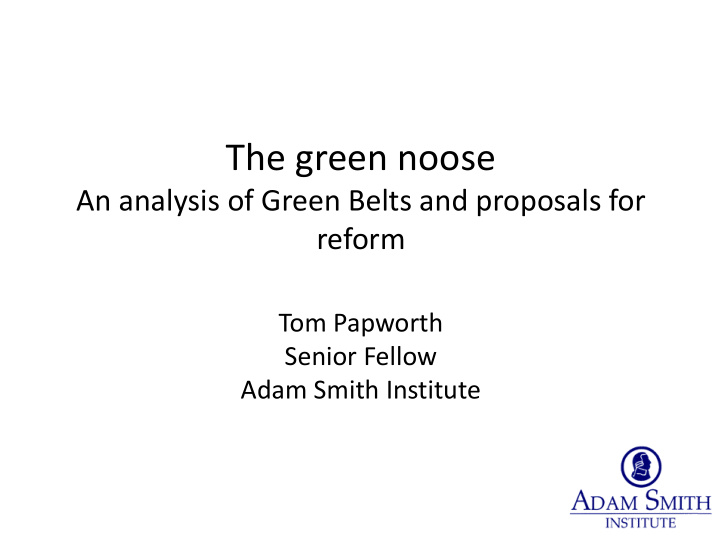



The green noose An analysis of Green Belts and proposals for reform Tom Papworth Senior Fellow Adam Smith Institute
Aim of the paper • Critical review of Green Belt policy • Do we need urban containment policies? • Are Green Belts justified in their own terms ? • Is popular support for Green Belts justified? • The paper does not • Make detailed proposals • Solve all challenges to urban planning • Concentrate on non-housing development
Land use in England Domestic gardens Buildings Transport Other land uses Green belt Greenspace other than Green Belt Water
Land use in international context Population density Percentage of land Amount of built environment per (p/sq km) mass developed capita (sq m/p) Belgium 370 18.6 551 Germany 231 13.2 557 Italy 203 9.7 500 Japan 349 9.0 n/a Korea, Republic of 517 n/a n/a Netherlands 498 17.0 363 United Kingdom 265 9.5 384 EU average 116.3 8.8 648
The root of the problem? “Just under one in ten English adults (9%) think that three-quarters or more of the country is built on and 63% think that more than a quarter is developed, much higher than the true proportion of a tenth .” Ipsos MORI, 9 May 2012
Green Belt Policy 1. To assist in safeguarding the countryside from encroachment
Green Belt Policy 1. To assist in safeguarding the countryside from encroachment 2. To check the unrestricted sprawl of large built-up areas
Green Belt Policy 1. To assist in safeguarding the countryside from encroachment 2. To check the unrestricted sprawl of large built-up areas “ The term 'urban sprawl' is … used loosely to refer to all that is bad about urban growth, and narrowly to describe specific aspects of urban growth which are considered undesirable.... The problem with some of these definitions is that they are based on misconceptions about how the land market operates. Since their premise is wrong, the policies they engender are often counter-productive .” - Richard Peiser, “Decomposing Urban Sprawl”, The Town Planning Review, Vol. 72, No. 3, 2001
Green Belt Policy 1. To assist in safeguarding the countryside from encroachment 2. To check the unrestricted sprawl of large built-up areas 3. To preserve the setting and special character of historic towns 4. To prevent neighbouring towns merging into one another
Green Belt Policy 1. To assist in safeguarding the countryside from encroachment 2. To check the unrestricted sprawl of large built-up areas 3. To preserve the setting and special character of historic towns 4. To prevent neighbouring towns merging into one another 5. To assist in urban regeneration, by encouraging the recycling of derelict and other urban land
Green Belt Policy 5. To assist in urban regeneration, by encouraging the recycling of derelict and other urban land “ We now have a planning system directed to achieve precisely the opposite of what was originally conceived in 1947 – allow the mass of the urban population more space and a greener environment in which to live ” – Paul Cheshire
Green Belt myth 1: Access to greenspace Land type Present benefit (per hectare per year, in 2001 £) Urban core public space (city 54,000 park) Urban fringe greenbelt 889 Urban fringe forested land 2,700 Rural forested land 6,626 Agricultural extensive 3,105 Agricultural intensive 103 Natural and semi-natural 6,616 wetlands
Green Belt myth 2: Environmental good
Welfare costs of the Green Belt 1. Increased cost of accommodation
Welfare costs of the Green Belt 1. Increased cost of accommodation 2. Packing households into smaller spaces
Welfare costs of the Green Belt 1. Increased cost of accommodation 2. Packing households into smaller spaces 3. House price volatility
Welfare costs of the Green Belt 1. Increased cost of accommodation 2. Packing households into smaller spaces 3. House price volatility 4. Increased cost of business premises
Welfare costs of the Green Belt 1. Increased cost of accommodation 2. Packing households into smaller spaces 3. House price volatility 4. Increased cost of business premises 5. Environmental and welfare costs
Welfare costs of the Green Belt 1. Increased cost of accommodation 2. Packing households into smaller spaces 3. House price volatility 4. Increased cost of business premises 5. Environmental and welfare costs 6. Other economic benefits
Three proposals for reform 1. Abolish and protect
Three proposals for reform 1. Abolish and protect “Green Belts constitute a major obstacle to development around cities, where housing is often needed. Replacing Green Belts by land – use restrictions that better reflect environmental designations would free up land for housing, while preserving the environment ” - OECD
Three proposals for reform 1. Abolish and protect 2. Declassify all intensive agricultural land
Three proposals for reform 1. Abolish and protect 2. Declassify all intensive agricultural land 3. Limited declassification of intensive agricultural land near Green Belt railway stations
The Green Noose - summary • UK is not over-populated or over-developed • The official justification for Green Belts is based on dubious assumptions • Green Belts do not deliver what people believe they deliver • We should • abolish Green Belts • protect genuinely important sites • Build 1m extra homes by 2025
Recommend
More recommend